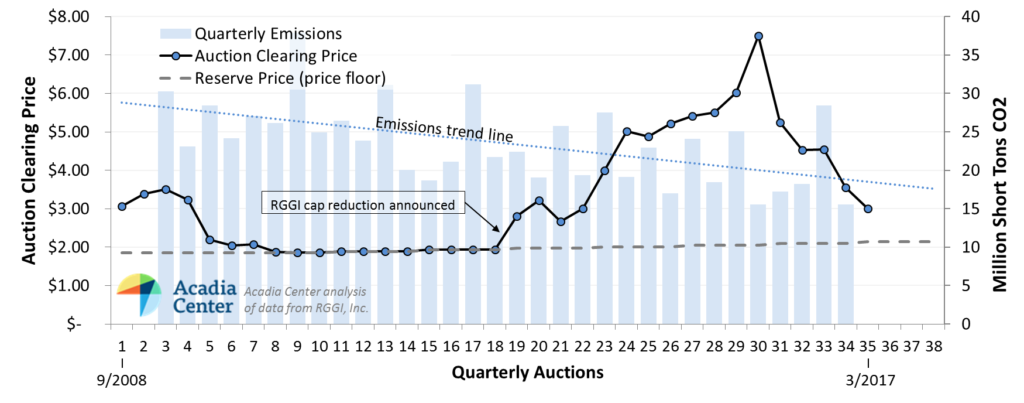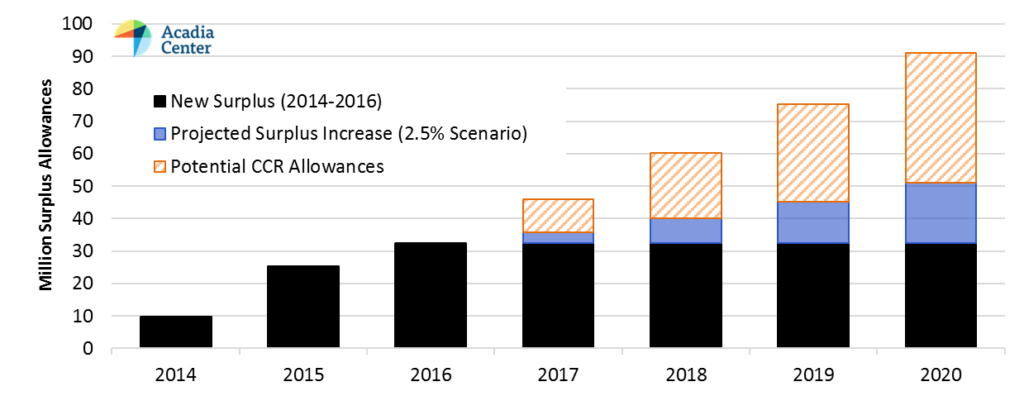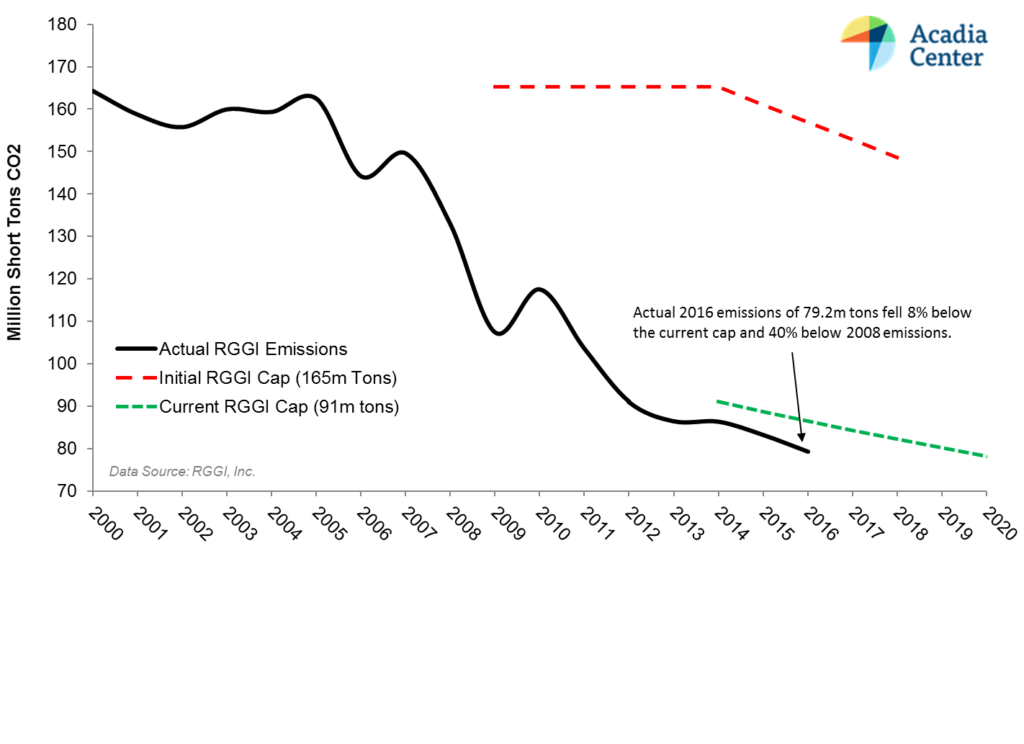Will CT catch or miss the boat on offshore wind energy?
But will that be too late?
“No I don’t think so,” said Peter Shattuck, director of the clean energy initiative and the Massachusetts office of the regional environmental advocacy group Acadia Center. “It’s taking off now, so if Connecticut acts within the next couple of years – the sooner the better … I would say they haven’t missed out yet. But some of the decisions given what other states are doing are going to be made in the near future.”
Read the full article from the CT Mirror here.
Federal rollbacks require states to lead the transition to a clean energy economy
BOSTON — Today’s announcement from the Trump Administration rolling back carbon pollution standards for power plants and weakening consideration of the societal costs of carbon pollution from the regulatory review process is the latest in a series of ill-informed actions that will damage the nation’s need to build a modern, less polluting and more consumer-friendly economic future. These actions by the Trump Administration underscore that Northeast states must act to protect existing climate policies and step up their commitments to address the threat of climate change.
“The Trump Administration is turning the nation’s back on the historic opportunity to build a clean energy future—a future that will modernize our energy system, offer consumers better value for their energy dollars and invest in state and local economies while taking the right steps to reduce climate pollution,” said Daniel Sosland, president of Acadia Center. “The Administration’s actions will increase pollution, damage public health and cost consumers more. Removing from federal decision making the impact carbon pollution has on society is a thinly-veiled attempt to make these backward decisions seem more economic. Leadership to safeguard consumers and the climate has now shifted to the states and cities, and Acadia Center is calling on states to respond by redoubling their commitments to a clean energy future and spurring market growth for clean power, energy efficiency and low polluting technologies.”
Northeast states have proven their leadership by implementing bipartisan climate and energy policies that enhance economic growth while cutting pollution. These state actions are now dramatically more important as the Trump Administration seeks to undermine environmental and climate protections. Key policies that states have put into place and must protect include:
- The Regional Greenhouse Gas Initiative (RGGI) cap and trade program, which has helped to reduce emissions from regional power plants 40% over 8 years of operation while raising $2.6 billion for states to reinvest in energy efficiency and consumer programs. Actual data shows that economic growth in the RGGI states exceeded other states. RGGI was implemented in response to federal inaction on climate change and provided a model for state-based policies at the heart of the Clean Power Plan pollution standards now being rejected by the Trump Administration.
- The Zero Emissions Vehicle (ZEV) agreement among Massachusetts, Rhode Island, Connecticut, New York, Vermont, Maryland, Oregon and California to put 3.3 million electric vehicles on the road by 2025. The ZEV program and decades of established leadership by California under the Clean Air Act may be the next target for federal rollbacks if EPA revokes the authority for California and thereby other states to adopt emissions standards more stringent than federal minimums.
- Cost-effective Energy Efficiency investment programs are leading the nation and delivering billions of dollars in energy cost savings, avoiding air pollution, and reducing strain on the grid. In the 6-state New England power grid alone, energy efficiency investments have improved the reliability of the grid and avoided nearly $500 million in consumer payments for unnecessary transmission infrastructure. ENERGY STAR, one of the core federal efficiency programs is targeted for elimination under the Trump Administration’s proposed federal budget.
- Renewable Energy development driven by state Renewable Portfolio Standards, solar policies, and coordinated procurement of several power plants worth of on- and offshore wind, solar and hydroelectricity is unlocking clean energy potential and helping to phase out dated fossil fuel options. Federal tax credits for renewable energy and continuing offshore wind leasing are critical to enabling clean energy deployment.
Additionally, Northeast states have made explicit commitments to address the threat of climate change. New England states have agreed to a 35%-45% reduction in carbon pollution by 2030, and cities and states in the region are signatories to a multi-national agreement to reduce climate pollution sufficiently by 2050 to limit global temperature increase to 2 degrees Celsius.
“There is broad public support for common-sense steps to rein in climate pollution,” said Peter Shattuck, Director of Acadia Center’s Clean Energy Initiative. “The elections didn’t halt climate change, but they created a void that must be filled by city, state and regional leadership on one of the greatest threats of our time.”
MEDIA CONTACTS:
Peter Shattuck, Director, Clean Energy Initiative
617-742-0054 x103, pshattuck@acadiacenter.org
Krysia Wazny, Communications Director
617-742-0054 x107, kwazny@acadiacenter.org
New Analysis Shows Outdated Rules Causing Utilities to Pursue High Priced Options; Eversource Rate Case More of the Same
BOSTON — New analysis from Acadia Center demonstrates that outdated financial incentives are driving expenditures on expensive and unnecessary utility infrastructure and inhibiting clean energy in the Northeast. Analysis of recent electric transmission and gas pipeline expansions demonstrates that utilities earn higher returns on these traditional expenditures than on local clean energy alternatives. The need to reform outdated incentives and change utility planning has come to stark relief in a rate case proposal from one of the region’s largest utilities. In it, Eversource proposes unprecedented returns on expenditures and electricity rates that inhibit clean energy while causing consumers to pay more than they should.
“Energy efficiency, community and rooftop solar, and smart energy management are revolutionizing the energy sector by offering clean, lower cost energy alternatives, but outdated incentive structures that provide high utility financial returns for old ways of doing business are standing in the way”, said Daniel Sosland, President of Acadia Center. “It’s time for the Commonwealth to seize the moment, save money for ratepayers and build a clean, lower carbon energy system.”
Acadia Center’s analysis Incentives for Change: Why Utilities Continue to Build and How Regulators Can Motivate Them to Modernize, shows through two examples of commonly financed energy projects — a transmission project in Maine and gas pipeline expansion in Connecticut — how utilities stand to earn far more from expensive, traditional infrastructure than from low cost clean energy alternatives.
“Under the current rules, it is impossible for consumers to have confidence that the millions of dollars we are all paying for energy infrastructure are the best choices for our environment and wallets,” said Abigail Anthony, Director of Acadia Center’s Grid Modernization Initiative. “The rules need to change to stimulate competition between traditional power plants, pipelines, and transmission and local solutions like solar, storage, and smart appliances.”
Utility financial incentives and grid planning rules are a part of Eversource’s rate case in Massachusetts. While advancing some important steps, too much of what Eversource proposes would undermine consumer control and clean energy incentives. On the positive side, Eversource proposes to “decouple” its revenue from electricity sales, which supports the Commonwealth’s efforts to ramp up energy efficiency. The company also proposes some potentially beneficial grid modernization investments, procurement of energy storage, and measures to help deploy more electric vehicle charging stations.
However, Eversource proposes other changes that exacerbate a regulatory structure that skews in favor of traditional projects over clean energy, including:
- Highest-in-the-region returns on equity of 10.5%, which would increase rewards for overbuild infrastructure rather than utilizing clean energy alternatives
- Automatic annual revenue increases of at least 3.5% (roughly $35 million) per year, rather than incentives to improve performance and achieve consumer and clean energy goals
- Higher fixed monthly charges and demand charges that reduce customer incentives to save or produce energy and disproportionately impact low income customers.
Additional information on proposals in Eversource’s rate case are available in Acadia Center’s summary analysis.
Contacts:
Abigail Anthony, Director, Grid Modernization Initiative
401.276.0600, aanthony@acadiacenter.org
Krysia Wazny, Communications Director
617.742.0054 x107, kwazny@acadiacenter.org
RGGI Emissions Fell Again in 2016
Declining Emissions Signal Need for Reform
In advance of expected actions by the Trump administration to remove or weaken federal climate protections, the Northeast’s pioneering climate program continues to see reductions in carbon pollution, reflected by today’s three-year low auction clearing price. Member states must now strengthen the Regional Greenhouse Gas Initiative to preserve the program’s effectiveness and signal commitment to continuing bi-partisan climate leadership.
Introduction
CO2 emissions from power plants have been steadily declining across the nine states of the Regional Greenhouse Gas Initiative (RGGI) for the last decade, and in 2016 fell 8.4 percent below the emissions cap. Since the program began in 2009, the decarbonization of the electric sector has been a major victory for the environment, health and economy of the region. Continued investments in clean energy and complementary climate policies in the participating states will help to achieve greater emissions reductions, but the RGGI states must do more to build on their first-in-the-nation program. Through the current Program Review,1 the participating states should strengthen RGGI to align the program with the current emissions trends and future climate goals.
Emissions
RGGI CO2 emissions fell to 79.2 million tons in 2016, a 4.7 percent decrease from 2015, marking the sixth consecutive year of power-sector emissions declines. Since 2008, the year before RGGI began, emissions are down 40.4 percent.
While several factors including growth in renewable energy, efficiency improvements, and fuel-switching have contributed to regional emissions reductions, a large share of these reductions has been attributed to the RGGI program.2 By establishing a price on carbon emissions and generating revenue for clean energy investments, RGGI has accelerated the transition to a cleaner electric sector. Increases in energy efficiency and growth in renewable energy output will enable the RGGI states to continue to achieve ambitious emissions reductions.
Figure 1: RGGI Emissions Continue to Fall
Market Dynamics
Auction Results
RGGI’s success has resulted in lower-than-expected emissions, which, in turn, have resulted in lower-than-projected compliance costs. With annual emissions falling below the RGGI cap in each of the program’s first eight years, there is an excess of allowances in circulation, leading to low allowance prices. Following ten consecutive auctions in which the auction clearing price was determined by the price floor—the lowest price at which allowances will be sold at a given auction—the RGGI states decided to reduce the cap by 45 percent. That decision had immediate impacts on the RGGI market, driving increased demand for allowances. Increased RGGI allowance prices proved to be temporary, however, as continued emissions reductions have outpaced the decline of the recently adjusted cap, creating an allowance oversupply. These conditions have resulted in falling allowance prices, with Auction 35 clearing at a three-year low of $3.00, 15 percent below the previous auction and 43 percent below the clearing price from one year ago.
Figure 2: Allowance Oversupply Leads to Low Auction Prices

Allowance Oversupply
RGGI, like nearly all emissions trading programs, has struggled with an oversupplied market. Emissions reductions have been achieved more quickly and cost effectively than projected, creating a large gulf between cap levels and actual emissions, as shown in Figure 1. This has led to a market flooded with low-priced allowances, diminishing the program’s impact and undermining the environmental integrity of the cap. Recognizing these problems, the RGGI states agreed during the previous Program Review to gradually eliminate allowances banked prior to 2014 by adjusting 2014-2020 cap levels downward.3
This innovative strategy has proved effective, but a new surplus of allowances has been accumulated since 2014, and we expect it to increase through 2020 as trends that have contributed to the decline in emissions (growth in renewable energy, efficiency improvements, and fuel-switching) continue to bring emissions down.
In the first three years under the new cap, emissions have fallen below cap levels by 4.7 million tons (2014), 5.6 million tons (2015) and 7.3 million tons (2016). Over these three years all available allowances have been purchased, creating a surplus of 17.6 million tons. Additional allowances purchased from the Cost Containment Reserve (CCR) have added to the surplus, introducing 15 million additional allowances without corresponding emissions to balance the market. This brings the new surplus to 32.6 million tons, as shown in Figure 3. If emissions follow projections under recent ICF modeling of a post-2020 2.5% cap decline,4 the surplus will grow to 52.8 million tons through 2020. If CCR allowances are purchased, that figure could grow by up to 40 million tons.
Figure 3: Allowance Surplus, 2014-2020

Need for Market Reform
The emissions reductions achieved by the RGGI states have been a tremendous success, but program reforms will be necessary to ensure that this success continues. As detailed in Part II of our RGGI Status Report: Achieving Climate Commitments,5 the RGGI states should make the following changes to strengthen the program:
- Establish a 2021-2030 cap that declines annually by 5% of the 2020 baseline;
- Commit to an adjustment for banked allowances accumulated from 2014-2020;
- Eliminate the CCR or increase CCR price triggers to ensure that CCR allowances are only purchased during periods of exceptionally high demand;
- Establish an Emissions Containment Reserve6 to capitalize on emissions reductions and to protect against future allowance oversupply; and
- Increase the auction reserve price to at least $4/ton to maintain a meaningful price on carbon emissions.
1For more information on the current RGGI Program Review, see: http://rggi.org/design/2016-program-review
2Why Have Greenhouse Emissions in RGGI States Declined? An Econometric Attribution to Economic, Energy Market, and Policy Factors, Brian Murray and Peter Maniloff, Duke Nicholas Institute, August 2015. Available at: https://nicholasinstitute.duke.edu/environment/publications/why-have-greenhouse-emissions-rggi-states-declined-econometric-attribution-economic
3This adjustment was conducted in two steps; one adjustment to account for allowances banked during the first control period (2009-2011) and a second adjustment for the second control period (2012-2014). For more information, see: https://www.rggi.org/docs/SCPIABA.pdf
4IPM modeling conducted by ICF for RGGI, Inc. available here: http://rggi.org/design/2016-program-review/rggi-meetings
5RGGI Status Report Part II: Achieving Climate Commitments, Acadia Center, August 2016. Available at: http://acadiacenter.org/wp-content/uploads/2016/08/Acadia-Center_RGGI-Report-2016_Part-II.pdf
6The Emissions Containment Reserve (ECR) was first proposed by the RGGI states during the November 21st, 2016 Stakeholder Webinar: http://rggi.org/docs/ProgramReview/2016/11-21-16/2016_Nov_21_ECR_Presentation.pdf. For more information on how the ECR might function, see: http://www.rff.org/events/event/2017-02/emissions-containment-reserve-rggi-how-might-it-work
Easing auto emissions rules would set back CT clean-air efforts
What got Blumenthal’s eyes to widen and had him energetically taking notes that afternoon in a spare New Haven City Hall conference room, was something said by Bill Dornbos, who runs the Connecticut office of the regional group Acadia Center. Dornbos – who is a lawyer – told Blumenthal that it would be pretty easy for Trump to get rid of the “California waiver.”
That bit of environmental wonk jargon, part of major revisions to the Clean Air Act in 1970, allows California to set its own stricter-than-federal standards for motor vehicle emissions. It also allows other states to use California’s standards instead of the federal ones.
[…]
Neither is improving. Greenhouse gas emissions went up 7.5 percent from 2012 to 2015, and probably even more in 2016, according to calculations from publicly available data done by Acadia Center, which attributes the rise primarily to the transportation sector. With gas prices low, driving is up dramatically in Connecticut along with sales of larger, less efficient vehicles.
[…]
And Acadia’s Dornbos said all options are on the table for them, including litigation. “We will not leave the future health and prosperity of Connecticut and the Northeast to arbitrary federal decisions that ignore basic science and the law,” he said.
Constructing our future with low-carbon buildings
A 2014 Acadia Center report commissioned by Natural Resources Canada examined the impact of Canadian energy efficiency policies on GDP and job creation. The researchers concluded that energy efficiency programs would spur a net increase in GDP, contributing $230 billion to $580 billion to the economy between 2012 and 2040. In fact, each $1 spent on energy efficiency programs in Canada would yield a GDP increase of between $5 and $8. Every $1 million invested in efficiency programs generates 30 to 52 job-years.
Read the full article on Policy Options here.



















